- September 9, 2024
- Posted by: Bikash Sharma
- Category: Awareness, Uncategorized

Understanding Insider Threats: A Comprehensive Guide
In our digitally interconnected world, organizations are not only battling external cyber threats but also grappling with a growing internal menace—insider threats. What was once deemed a rare occurrence has evolved into a prevalent and potent risk. Verizon’s Data Breach Investigations Report (DBIR) sheds crucial light on the nuances of insider threats and their profound impact on organizational security. This blog post will explore various insider threats, uncovering their motivations, illustrating real-world examples, and offering strategies to effectively combat them.
1. Careless Employees: The Unintentional Hazard
Careless employees, though not malicious, can pose a significant security threat through their unintentional actions. These individuals might accidentally click on phishing links, download harmful attachments, or inadvertently disclose sensitive information.
Example: A seemingly innocuous company-wide email campaign tricks employees with a phishing link promising a “free gift.” An unsuspecting employee clicks the link, unknowingly downloading malware that compromises the company’s entire network.
Mitigation Strategy: Implementing mandatory cybersecurity training and awareness programs can help employees recognize phishing attempts and practice safe online behavior.
2. Regular Employees: The Overlooked Risk
Even well-meaning regular employees can contribute to data breaches through lapses in security practices. Issues such as failing to change default passwords, using weak passwords, or neglecting secure devices can open the door to unauthorized access.
Example: An employee, feeling secure with their routine, leaves their laptop unattended in a public space. A thief seizes the opportunity to access the device, leading to the theft of sensitive company data.
Mitigation Strategy: Enforcing strong password policies, encouraging regular password changes, and emphasizing the importance of securing devices are crucial steps in minimizing this risk.
3. Malicious Insiders: The Intentional Threat
Malicious insiders are a grave concern due to their deliberate actions to exploit their privileged access. These individuals possess intimate knowledge of organizational systems and security measures, making their actions particularly damaging.
Example: A disgruntled employee with access to confidential customer databases siphons off sensitive data and sells it on the dark web, compromising client confidentiality and trust.
Mitigation Strategy: Regularly reviewing and auditing access privileges, coupled with implementing strict data handling protocols, can help mitigate the risk posed by malicious insiders.
4. Disgruntled Employees: The Vengeful Risk
Employees who are disgruntled or dissatisfied with their job situation may seek to disrupt operations or steal information for personal gain. This could manifest as system sabotage, data theft, or leaking confidential information.
Example: A recently terminated employee, harboring resentment, deletes critical data from the company’s servers before departing, resulting in major disruptions to business continuity.
Mitigation Strategy: Establishing clear exit procedures and conducting exit interviews can help identify potential risks and address grievances before they escalate into harmful actions.
5. Third Parties: The Extended Vulnerability
Third parties, including contractors, vendors, or partners, may have access to sensitive organizational data. Without rigorous vetting and monitoring, these external entities can misuse their access or become targets for attacks themselves.
Example: A contractor working on a high-profile project exploits their access to the company’s network, extracting proprietary information and jeopardizing the organization’s competitive edge.
Mitigation Strategy: Implementing thorough third-party risk assessments and monitoring their access closely can help prevent misuse and ensure compliance with security policies.
Proactive Measures for Mitigating Insider Threats
To effectively tackle insider threats, organizations must adopt a multifaceted security strategy:
- Employee Education and Training: Regular training on cybersecurity best practices, phishing awareness, and data privacy can empower employees to recognize and avoid potential threats.
- Access Controls: Restricting access to sensitive data and systems based on specific job roles and responsibilities is vital to minimizing risk.
- Monitoring and Detection: Employing advanced monitoring and detection tools can help identify suspicious activities and potential insider threats before they escalate.
- Incident Response Planning: Developing a well-defined incident response plan ensures a swift and effective reaction to data breaches, minimizing potential damage.
- Risk Assessment: Conducting regular risk assessments helps uncover vulnerabilities and implement measures to address them proactively.
Conclusion
Insider threats present a complex and evolving challenge, with potential impacts that can be devastating to an organization’s security and reputation. By understanding the various types of insider threats and implementing robust mitigation strategies, organizations can significantly enhance their defenses and safeguard their sensitive data. Verizon’s DBIR offers valuable insights into these threats, helping organizations stay informed and proactive in their cybersecurity efforts.
